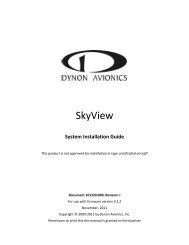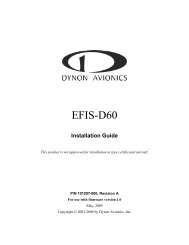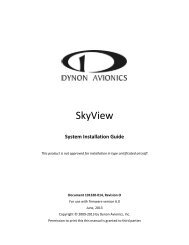EFIS-D100 Installation Guide - Dynon Avionics
EFIS-D100 Installation Guide - Dynon Avionics
EFIS-D100 Installation Guide - Dynon Avionics
Create successful ePaper yourself
Turn your PDF publications into a flip-book with our unique Google optimized e-Paper software.
Autopilot <strong>Installation</strong> and Configuration<br />
Altitude Gain (ALT GAIN): Use only after sensitivity and all of the above settings are set as<br />
well as they can be. Increase gradually if airplane levels off too soon. Reduce gradually if<br />
airplane overshoots altitudes after climbs and descents. The default setting is 6.<br />
Pull Rate: Use only after sensitivity and all of the above settings are set as well as they can<br />
be. Controls the rate the AP will push or pull when changing vertical speed. The default<br />
setting is 10.<br />
VSI Gain: Use only after sensitivity and all of the above settings are set as well as they can<br />
be. Increase gradually if overshooting altitude after climbs or descents, decrease if rounding<br />
out too early. The default setting is 15.<br />
G Error Gain (G ERR GAIN): Use only after sensitivity and all of the above settings are set<br />
as well as they can be. Increase gradually if vertical speed changes are not smoothed enough;<br />
Decrease if ride is too harsh. G Error Gain adjustments affect the most noticeable changes<br />
while the aircraft is in turbulence. The default setting is 10.<br />
G Error Limit (G ERR LIM): Use only after sensitivity and all of the above settings are set as<br />
well as they can be. Controls the max additional G the autopilot will push or pull to control<br />
vertical speed (up to the G limiter). G Error Limit adjustments affect the most noticeable<br />
changes while the aircraft is in turbulence. The default setting is 25.<br />
Step 4c – Set Airspeed Minimum: The PITCH SERVO > AIRSP MIN parameter must be set to<br />
at least (and defaults to) 30% above V S1 , which should be set to the specifications of your<br />
aircraft in the <strong>EFIS</strong> > SETUP > IASCLR menu. The AP cannot be engaged at airspeeds below<br />
Airspeed Minimum, with the exception of 0 knots, allowing for ground testing. When flying at<br />
airspeeds lower than AIRSP MIN, the AP status indicator displays “SPD” for both axes, and<br />
cannot be engaged.<br />
When the AP is engaged and aircraft airspeed drops below the minimum, the AP enters an<br />
airspeed hold mode, sacrificing altitude hold performance to maintain the minimum airspeed.<br />
When the aircraft’s altitude drops below the target ALT bug and the AP cannot pitch the aircraft<br />
up without dropping below the minimum airspeed, the <strong>EFIS</strong> presents the prompt:<br />
MIN AIRSPEED – ADD POWER<br />
Airspeed Minimum is specified in knots, kilometers/hr, or miles/hr, depending on the units<br />
chosen in the <strong>EFIS</strong> > SETUP > UNITS > IAS menu. Minimum/default: 30% above V S1 .<br />
To set the AIRSP MIN, perform the following (continuing from Pitch Servo Sensitivity):<br />
DOWN▼ > (AIRSP MIN: value is highlighted)<br />
Press DEC - and INC + to adjust APRSP MIN to preferred initial setting for the aircraft.<br />
Step 4d – Set Pitch Servo Airspeed Maximum: The PITCH SERVO > AIRSP MAX<br />
parameter cannot be set to a value above 95% of V NE , which should be set to the specifications<br />
of your aircraft in the <strong>EFIS</strong> > SETUP > IASCLR menu. The AP cannot be engaged at airspeeds<br />
above Airspeed Maximum. When flying at airspeeds above AIRSP MAX, the AP status<br />
indicator displays “SPD” for both axes, and cannot be engaged.<br />
When the AP is engaged and aircraft airspeed rises above the maximum, the AP enters an<br />
airspeed hold mode, pitching the aircraft up to prevent exceeding the maximum airspeed.<br />
When the aircraft’s altitude rises above the target ALT bug and the AP cannot pitch the aircraft<br />
down without going above the maximum airspeed, the <strong>EFIS</strong> presents the prompt:<br />
6-20 <strong>EFIS</strong>-<strong>D100</strong> <strong>Installation</strong> <strong>Guide</strong>
















